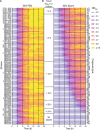Capsular Polysaccharide Is Essential for the Virulence of the Antimicrobial-Resistant Pathogen Enterobacter hormaechei
- PMID: 36779722
- PMCID: PMC10127600
- DOI: 10.1128/mbio.02590-22
Capsular Polysaccharide Is Essential for the Virulence of the Antimicrobial-Resistant Pathogen Enterobacter hormaechei
Abstract
Nosocomial infections caused by multidrug-resistant (MDR) Enterobacter cloacae complex (ECC) pathogens are on the rise. However, the virulence strategies employed by these pathogens remain elusive. Here, we study the interaction of ECC clinical isolates with human serum to define how this pathogen evades the antimicrobial action of complement, one of the first lines of host-mediated immune defense. We identified a small number of serum-sensitive strains, including Enterobacter hormaechei strain NR3055, which we exploited for the in vitro selection of serum-resistant clones. Comparative genomics between the serum-sensitive NR3055 strain and the isolated serum-resistant clones revealed a premature stop codon in the wzy gene of the capsular polysaccharide biosynthesis locus of NR3055. The complementation of wzy conferred serum resistance to NR3055, prevented the deposition of complement proteins on the bacterial surface, inhibited phagocytosis by human neutrophils, and rendered the bacteria virulent in a mouse model of peritonitis. Mice exposed to a nonlethal dose of encapsulated NR3055 were protected from subsequent lethal infections by encapsulated NR3055, whereas mice that were previously exposed to unencapsulated NR3055 succumbed to infection. Thus, capsule is a key immune evasion determinant for E. hormaechei, and it is a potential target for prophylactics and therapeutics to combat these increasingly MDR human pathogens. IMPORTANCE Infections caused by antimicrobial resistant bacteria are of increasing concern, especially those due to carbapenem-resistant Enterobacteriaceae pathogens. Included in this group are species of the Enterobacter cloacae complex, regarding which there is a paucity of knowledge on the infection biology of the pathogens, despite their clinical relevance. In this study, we combine techniques in comparative genomics, bacterial genetics, and diverse models of infection to establish capsule as an important mechanism of Enterobacter pathogens to resist the antibacterial activity of serum, a first line of host defense against bacterial infections. We also show that immune memory targeting the Enterobacter capsule protects against lethal infection. The further characterization of Enterobacter infection biology and the immune response to infection are needed for the development of therapies and preventative interventions targeting these highly antibiotic resistant pathogens.
Keywords: Enterobacter; antimicrobial resistance; capsule; complement; pathogenesis; serum; serum resistance.
Conflict of interest statement
The authors declare no conflict of interest.
Figures









Similar articles
-
Enterobacter hormaechei replaces virulence with carbapenem resistance via porin loss.Proc Natl Acad Sci U S A. 2025 Feb 25;122(8):e2414315122. doi: 10.1073/pnas.2414315122. Epub 2025 Feb 20. Proc Natl Acad Sci U S A. 2025. PMID: 39977318 Free PMC article.
-
Some virulence genes are associated with antibiotic susceptibility in Enterobacter cloacae complex.BMC Infect Dis. 2024 Jul 19;24(1):711. doi: 10.1186/s12879-024-09608-2. BMC Infect Dis. 2024. PMID: 39030479 Free PMC article.
-
Whole genome sequence-based molecular characterization of blood isolates of carbapenem-resistant Enterobacter cloacae complex from ICU patients in Kolkata, India, during 2017-2022: emergence of phylogenetically heterogeneous Enterobacter hormaechei subsp. xiangfangensis.Microbiol Spectr. 2024 Apr 2;12(4):e0352923. doi: 10.1128/spectrum.03529-23. Epub 2024 Feb 22. Microbiol Spectr. 2024. PMID: 38385742 Free PMC article.
-
Antibiotic resistance in Enterobacter hormaechei.Int J Antimicrob Agents. 2022 Oct;60(4):106650. doi: 10.1016/j.ijantimicag.2022.106650. Epub 2022 Aug 4. Int J Antimicrob Agents. 2022. PMID: 35934231 Review.
-
Enterobacter cloacae complex: clinical impact and emerging antibiotic resistance.Future Microbiol. 2012 Jul;7(7):887-902. doi: 10.2217/fmb.12.61. Future Microbiol. 2012. PMID: 22827309 Review.
Cited by
-
Genomic Study of High-Risk Clones of Enterobacter hormaechei Collected from Tertiary Hospitals in the United Arab Emirates.Antibiotics (Basel). 2024 Jun 26;13(7):592. doi: 10.3390/antibiotics13070592. Antibiotics (Basel). 2024. PMID: 39061274 Free PMC article.
-
Whole-Genome Analysis of Extensively Drug-Resistant Enterobacter hormaechei Isolated from a Patient with Non-Hodgkin's Lymphoma.Genes (Basel). 2024 Jun 20;15(6):814. doi: 10.3390/genes15060814. Genes (Basel). 2024. PMID: 38927749 Free PMC article.
-
Genome sequence-based species classification of Enterobacter cloacae complex: a study among clinical isolates.Microbiol Spectr. 2024 Jun 4;12(6):e0431223. doi: 10.1128/spectrum.04312-23. Epub 2024 Apr 30. Microbiol Spectr. 2024. PMID: 38687068 Free PMC article.
-
Enterobacter hormaechei replaces virulence with carbapenem resistance via porin loss.Proc Natl Acad Sci U S A. 2025 Feb 25;122(8):e2414315122. doi: 10.1073/pnas.2414315122. Epub 2025 Feb 20. Proc Natl Acad Sci U S A. 2025. PMID: 39977318 Free PMC article.
-
Molecular basis of the phenotypic variants arising from a Pseudoalteromonas lipolytica mutator.Microb Genom. 2023 Oct;9(10):001118. doi: 10.1099/mgen.0.001118. Microb Genom. 2023. PMID: 37850970 Free PMC article.
References
-
- Ludden C, Reuter S, Judge K, Gouliouris T, Blane B, Coll F, Naydenova P, Hunt M, Tracey A, Hopkins KL, Brown NM, Woodford N, Parkhill J, Peacock SJ. 2017. Sharing of carbapenemase-encoding plasmids between Enterobacteriaceae in UK sewage uncovered by MinION sequencing. Microb Genom 3:e000114. doi:10.1099/mgen.0.000114. - DOI - PMC - PubMed
Publication types
MeSH terms
Substances
Supplementary concepts
Grants and funding
LinkOut - more resources
Full Text Sources
Molecular Biology Databases
